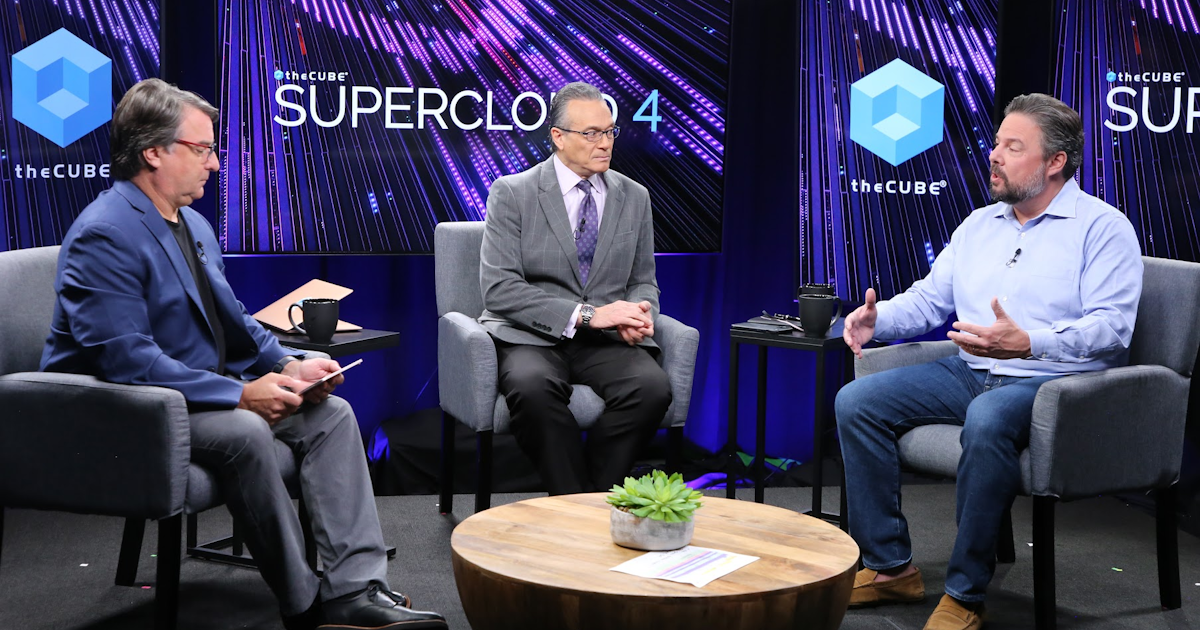 AI
AI
 AI
AI
 AI
AI
Generative AI is no longer confined to academic discussions. It has evolved into a business phenomenon, one that has begun to redefine industries.
Today’s Supercloud 4 event — a quarterly series from SiliconANGLE Media and theCUBE dedicated to reporting on evolving supercloud technology — explores the contours of generative AI, including how enterprises in a wide range of industries are looking to leverage and profit from gen AI and the challenges they face implementing this once-in-a-generation technological explosion.
Although spending on AI is steadily increasing, the majority of it is still experimental, according to theCUBE’s Dave Vellante (pictured, center).
“I saw a note from Gartner saying IT spending in 2024 is going to grow by 8.5%,” he said. “There is currently no evidence … that AI initiatives are stealing from other budgets. AI is by far now the No. 1 sector in terms of spending momentum, and it’s stealing from other areas.”
This resonates with the point made by MIT professor and economist Erik Brynjolfsson, who emphasized that while spending aligns with the hype, it hasn’t yet translated into a productivity boost, according to Vellante. Brynjolfsson expects that productivity could increase from its current 1.2% to as much as 4% or more.
Vellante and his co-analysts John Furrier (left) and Rob Strechay (right) opened the Supercloud 4 event with key insights and analysis, during an exclusive broadcast on theCUBE, SiliconANGLE Media’s livestreaming studio.
Generative AI is at the forefront of technology trends and enterprise interest. While the focus on AI and machine learning is unequivocal, a pivotal point that stands out is the crucial role of data in driving AI initiatives.
“I think what we’re seeing is that really people are focused on those segmented language models or smaller language models and being focused, like I’m using it for HR, I’m using it for finance, and bringing that data together because they own that,” Strechay said. “And that’s their IP, but there’s big security concerns.”
This statement underscores that data isn’t just an asset; it’s the very foundation that enables organizations to create highly specialized AI models that address particular use-cases like HR and finance. These models, often shaped by proprietary data, are becoming the intellectual property and competitive edge for businesses.
There is no one-size-fits-all playbook for AI adoption. From conservative to cutting-edge companies, each organization’s approach to AI is influenced by its data strategy, resources and objectives. Security, compliance and governance around data remain significant hurdles, emphasizing that effective data management is as crucial as the AI algorithms themselves. The multi-faceted conversation suggests that while AI may be the buzzword of the moment, it’s the intricate dance between data and algorithms that will ultimately dictate the success of AI initiatives in the enterprise.
AI’s impact in the enterprise is on full display right now, from experimentation to practical implementation. While gen AI technology is promising, it isn’t without its challenges.
“The big blockers to implementing gen AI in production are privacy, data privacy, security, compliance and governance, so that’s where these specialized models are going to have to shine,” Vellante said.
This emphasizes the hurdles companies still have to clear in order to mainstream AI usage, a notion that seems to resonate with the overarching theme of the discussion — that while AI is exciting and has enormous potential, there’s still a gap between the hype and the actual, measurable impact on productivity and operations.
In that sense, theCUBE’s analyst commentary mirrors broader debates in the technology world about the practical barriers that stand in the way of AI adoption that can’t be ignored. These barriers not only necessitate caution, but also direct the kind of AI strategies companies adopt, whether that’s focusing on specialized, proprietary models to maintain data integrity or leveraging larger, more generalized models for other purposes.
Given these challenges, it seems that the road to AI adoption is more of a marathon than a sprint, requiring sustained commitment to overcoming complex issues, according to the analysts.
Perhaps what stood out most during the panel discussion was the focus on future development.
“I think we’re going to see a neural network AI system emerge,” Furrier said. “The middleware is the data, and the apps are either going to be AI wrappers, like we’re seeing today, or other cloud-native, AI-native [services].”
The idea is that specialized models, driven by proprietary data sets, will be where most of the industry action is.
Watch the complete video interview, part of SiliconANGLE’s and theCUBE’s coverage of Supercloud 4:
THANK YOU